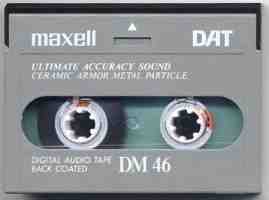Digital Audio Tape
Digital Audio Tape (
DAT or
R-DAT) is a signal recording and playback medium developed by Sony and introduced in 1987.
In appearance it is similar to a Compact Cassette, using 4 mm magnetic tape
enclosed in a protective shell, but is roughly half the size at 73 mm ×
54 mm × 10.5 mm. As the name suggests, the recording is digital rather than analog. DAT has the ability to record at higher, equal or lower sampling rates than a CD (48, 44.1 or 32 kHz sampling rate respectively) at 16 bits quantization. If a digital source is copied then the DAT will produce an exact clone, unlike other digital media such as Digital Compact Cassette or non-Hi-MD MiniDisc, both of which use a lossy data reduction system.
Like most formats of videocassette, a DAT cassette may only be recorded and played in one direction, unlike an analog compact audio cassette.
Although intended as a replacement for audio cassettes, the format
was never widely adopted by consumers because of issues of expense and
concerns from the music industry about unauthorized digital quality
copies. The format saw moderate success in professional markets and as a
computer storage medium. As Sony has ceased production of new
recorders, it will become more difficult to play archived recordings in
this format unless they are copied to other formats or hard drives.
Uses of DAT
Professional recording industry
DAT was used professionally in the 1990s by the professional audio
recording industry as part of an emerging all-digital production chain
also including digital multi-track recorders and digital mixing consoles
that was used to create a fully digital recording. In this
configuration, it is possible for the audio to remain digital from the
first AD converter after the mic preamp until it is in a CD player.
Pre-recorded DAT
In May 1988, Wire's album
The Ideal Copy became the first popular music recording to be commercially released on DAT format.
Several other albums from multiple record labels were also released as
pre-recorded DAT tapes in the first few years of the format's existence,
in small quantities as well.
Amateur and home use
DAT was envisaged by proponents as the successor format to analogue
audio cassettes in the way that the compact disc was the successor to
vinyl-based recordings. It sold well in Japan, where high-end consumer
audio stores stocked DAT recorders and tapes into the 2010s and
second-hand stores generally continued to offer a wide selection of mint
condition machines. However, there and in other nations, the technology
was never as commercially popular as CD or cassette. DAT recorders
proved to be comparatively expensive and few commercial recordings were
available. Globally, DAT remained popular, for a time, for making and
trading recordings of live music (see bootleg recording), since available DAT recorders predated affordable CD recorders.
Computer data storage medium
The format was designed for audio use, but through the ISO Digital Data Storage
standard was adopted for general data storage, storing from 1.3 to 80
GB on a 60 to 180 meter tape depending on the standard and compression.
It is a sequential-access medium and is commonly used for backups.
Due to the higher requirements for capacity and integrity in data
backups, a computer-grade DAT was introduced, called DDS (Digital Data
Storage). Although functionally similar to audio DATs, only a few DDS
and DAT drives (in particular, those manufactured by Archive for SGI workstations)
are capable of reading the audio data from a DAT cassette. SGI DDS4
drives no longer have audio support; SGI removed the feature due to
"lack of demand".

 About
About Tags
Tags Popular
Popular Google+
Google+
0 comments:
Post a Comment